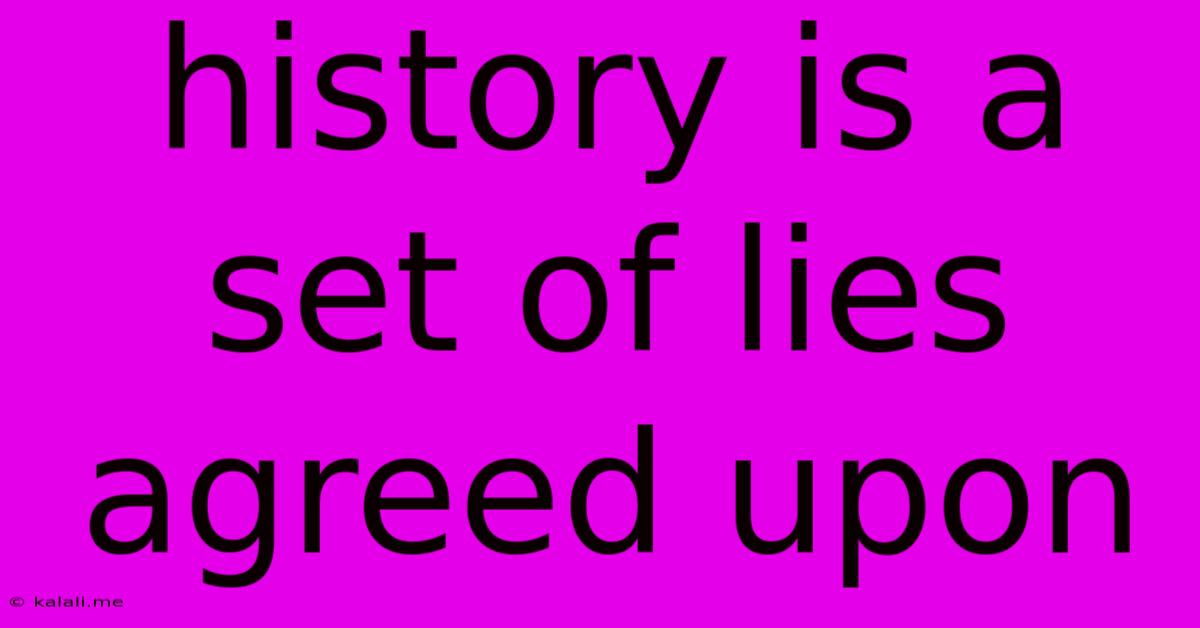History Is A Set Of Lies Agreed Upon
Kalali
Jun 01, 2025 · 3 min read

Table of Contents
History: A Set of Lies Agreed Upon? Deconstructing the Narrative
The provocative statement, "History is a set of lies agreed upon," often attributed to Napoleon Bonaparte (though its origin is debated), compels us to critically examine how history is constructed, interpreted, and ultimately, remembered. While not literally a collection of falsehoods, the phrase highlights the inherent subjectivity and biases that shape historical narratives. This article delves into the complexities of historical record-keeping, exploring the forces that influence what stories are told, and how we can approach history with a more nuanced and critical eye.
The Subjectivity of Historical Accounts:
History isn't simply a recitation of events; it's a complex interpretation of those events. The selection of which events to include, which sources to prioritize, and the language used to describe them all contribute to a particular narrative. Historians, despite striving for objectivity, are products of their own time and context. Their personal beliefs, cultural background, and even the prevailing political climate can unconsciously influence their work. Think about how different historical accounts of the same war might emerge from the perspectives of the victorious nation versus the defeated. Each account will emphasize different aspects, highlight different heroes, and present contrasting interpretations of the conflict's causes and consequences.
Power Dynamics and Historical Bias:
The writing of history has often been controlled by those in power. The victors write the history books, as the saying goes. This means that the perspectives of marginalized groups, women, ethnic minorities, and the lower classes, are often underrepresented or distorted. Their experiences, their struggles, and their contributions are frequently overlooked in favor of narratives that uphold the status quo. This intentional or unintentional bias leads to a skewed understanding of the past, making it crucial to actively seek out diverse historical voices and perspectives to construct a more complete picture.
The Role of Sources and Evidence:
Even seemingly objective historical sources – official documents, letters, and artifacts – can be subject to interpretation and manipulation. Documents can be forged, selectively edited, or taken out of context. Archaeological findings can be misinterpreted or used to support pre-existing biases. The availability and accessibility of historical sources themselves can also limit our understanding. Many historical records are lost, destroyed, or inaccessible to researchers, leading to gaps in our knowledge and the potential for skewed interpretations.
Navigating the Complexity: Towards a More Critical Understanding of History:
To avoid accepting history as simply “a set of lies agreed upon,” we must develop a critical and analytical approach to the subject. This involves:
- Considering Multiple Perspectives: Seek out diverse viewpoints and compare and contrast different historical accounts.
- Identifying Bias: Be aware of the potential biases inherent in historical sources and the narratives they present.
- Examining the Sources: Critically analyze the origins, authorship, and context of historical sources.
- Understanding the Limitations: Acknowledge that historical understanding is always partial and incomplete, and new evidence can always emerge to challenge existing interpretations.
- Engaging with Primary Sources: Whenever possible, consult primary sources – firsthand accounts, letters, diaries, and artifacts – to gain a more direct understanding of the past.
In conclusion, while the phrase "History is a set of lies agreed upon" might be an overstatement, it serves as a potent reminder of the inherent complexities and biases that shape our understanding of the past. By adopting a critical and nuanced approach, we can move beyond simplistic narratives and build a richer, more complete, and ultimately, more accurate understanding of history. It’s not about uncovering a singular "truth," but rather, acknowledging the multifaceted nature of the past and engaging in ongoing dialogue and revision.
Latest Posts
Latest Posts
-
He Who Finds A Wife Finds
Jun 02, 2025
-
How To Get Rid Of Geese In Your Yard
Jun 02, 2025
-
I M Good How Are You In Spanish
Jun 02, 2025
-
How To Wire A 9v Battery
Jun 02, 2025
-
How To Get Gengar In Pokemon X
Jun 02, 2025
Related Post
Thank you for visiting our website which covers about History Is A Set Of Lies Agreed Upon . We hope the information provided has been useful to you. Feel free to contact us if you have any questions or need further assistance. See you next time and don't miss to bookmark.